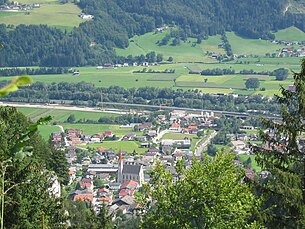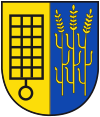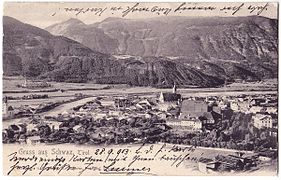Stans (Tyrol)
|
Stans
|
||
|---|---|---|
| coat of arms | Austria map | |
|
|
||
| Basic data | ||
| Country: | Austria | |
| State : | Tyrol | |
| Political District : | black | |
| License plate : | SZ | |
| Surface: | 20.06 km² | |
| Coordinates : | 47 ° 22 ' N , 11 ° 43' E | |
| Height : | 563 m above sea level A. | |
| Residents : | 2,132 (January 1, 2020) | |
| Postal code : | 6135 | |
| Area code : | 05242 | |
| Community code : | 7 09 28 | |
| NUTS region | AT335 | |
| Address of the municipal administration: |
Unterdorf 62 6135 Stans |
|
| Website: | ||
| politics | ||
| Mayor : | Michael Huber (Stans Citizens List) |
|
|
Municipal Council : (2016) (13 members) |
||
| Location of Stans in the Schwaz district | ||
 Stans from the north with the Herz-Jesu-Kirche |
||
| Source: Municipal data from Statistics Austria | ||
Stans is a municipality with 2132 inhabitants (as of January 1, 2020) in the district of Schwaz , Tyrol ( Austria ).
Geographical location
Stans is located in the Lower Inn Valley on the left side of the Inn, near Schwaz. The town center extends over an alluvial cone of the Stanser Bach.
Community structure
Stans consists of a single cadastral community of the same name and is divided into three localities (residents as of January 1, 2020):
- Impact turn (100)
- Stans (2024)
- Tratzberg (8)
The districts of Unterdorf, Oberdorf, Heimwald, Vogelsang, Am Rain, Berchat, Kirchfeld, Schloss Tratzberg , Dornau, Durrach, Heuberg, Rossweide, St. Georgenberg, Tenniscenter and Stanser Au belong to Stans.
Neighboring communities
All neighboring communities are in the Schwaz district.
| Right on the Achensee | Jenbach | |

|
Book in Tyrol | |
| Vomp | black |
history
The name Stans appears for the first time in the so-called Quartinus document from the year 827 AD as “Stauanes” , when the Breonian Nurihtaler Quarti (nus) transferred ownership to the San Candido monastery , although the naming cannot be clearly related to Stans.
The oldest traces of settlement go back to the first millennium BC. Archaeological investigations were carried out on the castle hill near Stans from 1952 to 1957. Remnants of buildings from the late Hallstatt and Latène periods were uncovered, including residential buildings and fireplaces. The largest building from the Latène period measured approximately 8 × 9 m in the square. Both the Hallstatt and the Latène settlements were destroyed by fire - in both cases the fire sites were apparently soon searched for useful items.
Rathold von Aibling, a Rapotone and landowner in Stans, is considered the founder of St. Georgenberg (around 950).
The old church, consecrated to Saints Laurentius and Ulrich, was mentioned in a document in 1337. The church patronage Laurentius alone suggests a very old place of worship. Excavation finds indicate that the first church was built in the 5th century. Thus, Stans is one of the very few places in North Tyrol whose church history goes back to the time of the first missionary work in the country.
Since 1470 Stans had a share in the Schwaz silver and copper mining. Smelting works were located on the Stanserbach and the Tänzl family's trade house ( Silberbrenner ) has been preserved from that time.
Tratzberg Castle was mentioned for the first time in 1296. The sovereign princes, the Freundsbergers , the Tänzl trade family, the wealthy Fuggers and the Counts of Tannenberg were once owners of Tratzberg. The castle has been owned by Count Enzenberg since 1848 .
The Ahrner copper union of Count Tannenberg set up a Leonische wire goods factory in 1802 , which to this day produces a wide variety of products from fine silver and copper wires.
From 1890 until the First World War there was the first Kneipp facility in Tyrol in Stans .
coat of arms
In 1960 Stans received the municipal coat of arms from the Tyrolean provincial government.
Blazon (coat of arms description):
- "A shield split by gold and blue with an upright black rust in the golden field and three golden ears of wheat in the blue field."
The colors of the municipality flag: yellow-blue.
Reason: The grate of St. Lawrence symbolizes the patronage of the old parish church. The ears of wheat, which come from the supposed coat of arms of Ratold von Aibling , are remembered for the founder of the Georgenberg monastery.
Economy and Infrastructure
Large and medium-sized companies have settled in the Dornau industrial estate , including the fruit juice and jam producer Darbo , which has a long tradition . This helps Stans to achieve a positive commuter balance. Alongside Darbo, the Gschwentner family company, Travel Europe , is the largest employer in town. Stans has also become more interesting as a recreational village for tourists.
Traffic default, the place about the exit is Schwaz of the Inn Valley motorway A 12 and a stop on the Western Railway opened.
Culture and sights
- Old parish church of Stans
- The Roman Catholic Church of the Sacred Heart of Jesus , built between 1885 and 1896, is worth seeing in the village . It was built in the neo-Gothic style and has a high altar that was modeled on the altar of the Brussels Cathedral . Above Stans is the small pilgrimage church Maria Tax, built in 1667, with frescoes by the famous painter Christoph Anton Mayr . At the west entrance of the village there is a stone wayside shrine from around 1500.
- The St. Georgenberg Monastery, which can be reached via the Wolfsklamm , is one of the most popular pilgrimage sites in Tyrol, and Tratzberg Castle , located on a north-eastern hill, is important for tourism . The Wolfsklamm has been opened up since 1901, a consequence of the wellness tourism in Stans at the time. A section of the Way of St. James runs through Stans , which stretches from Jenbach via Stans, St. Georgenberg Monastery, to Vomp , Fiecht Monastery , and from there via Terfens to the Umlberg, Maria Larch pilgrimage church .
- A very peculiar form of knocking has been preserved in Stans during Advent. This age-old custom is only performed every ten years.
Laurentiuskirche (left) and Herz-Jesu-Kirche (right); Eiblschrofen .
Personalities
From Stans came:
- the painter Josef Arnold the Elder (1788–1879)
- the freedom fighter Anton Obrist (1759-1834) and
- his son, the peasant poet Hans Obrist
- Johann Kellerer, court gardener to the Bulgarian king
Web links
- 70928 - Stans. Community data, Statistics Austria .
Individual evidence
- ↑ Statistics Austria: Population on January 1st, 2020 by locality (area status on January 1st, 2020) , ( CSV )
- ↑ Municipality of Stans on RiSKommunal, accessed on September 21, 2010
- ↑ Martin Bitschnau , Hannes Obermair : Tiroler Urkundenbuch, II. Department: The documents on the history of the Inn, Eisack and Pustertal valleys. Vol. 1: Up to the year 1140 . Universitätsverlag Wagner, Innsbruck 2009, ISBN 978-3-7030-0469-8 , p. 61-64, No. 86 .
- ^ Susanne Sievers / Otto Helmut Urban / Peter C. Ramsl: Lexicon for Celtic Archeology. A-K and L-Z ; Announcements of the prehistoric commission in the publishing house of the Austrian Academy of Sciences , Vienna 2012, ISBN 978-3-7001-6765-5 , p. 283 f.












